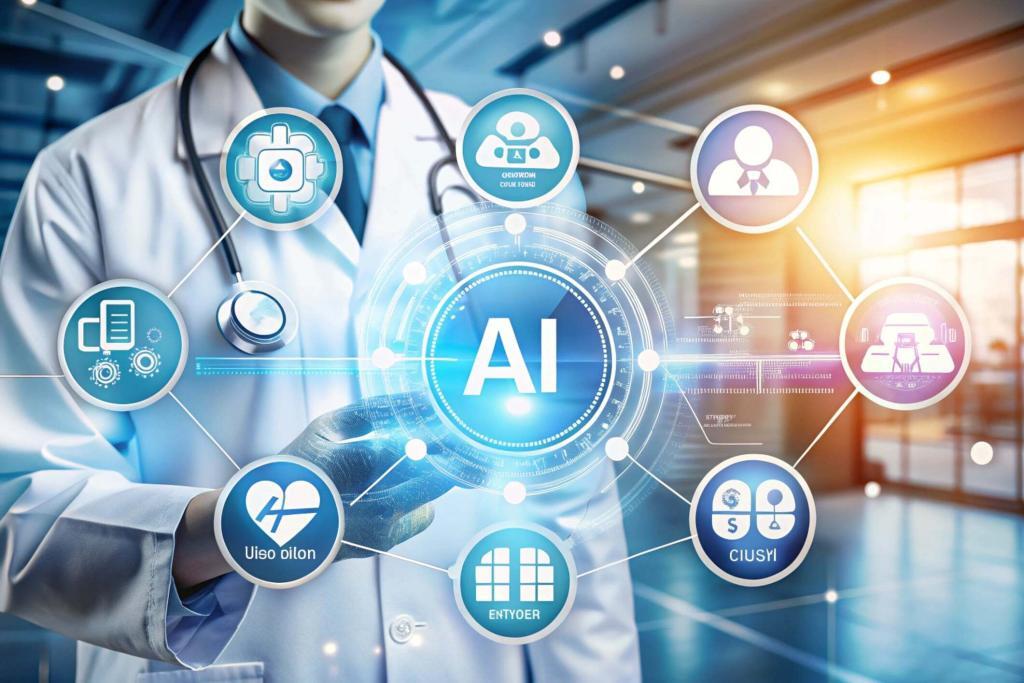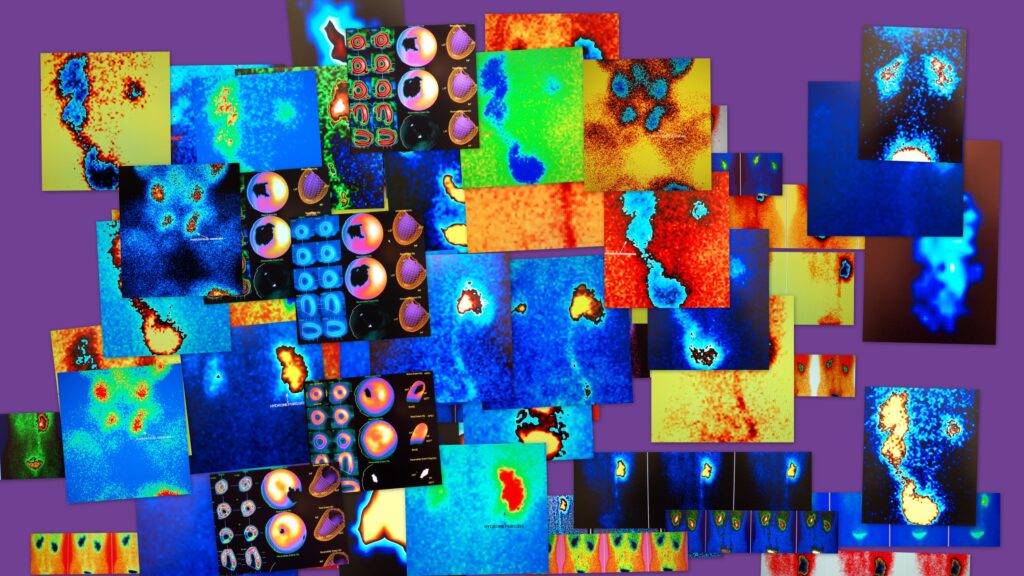Summary: Artificial Intelligence (AI) significantly enhances magnetic resonance imaging (MRI) by improving image quality, accelerating scanning procedures, facilitating accurate diagnoses, and optimising treatment planning. Also, AI-driven innovations streamline workflow efficiency and present the potential to minimise the necessity for contrast agents, thus enhancing patient safety and comfort.
Keywords: Image Quality; Scan Acceleration; Diagnostic Accuracy; Treatment Planning; Workflow Efficiency; Contrast Agent Reduction.
Image Quality
Magnetic resonance imaging (MRI) provides superior soft-tissue contrast, non-invasiveness, and diagnostic capabilities. However, achieving consistently high-quality images can be challenging due to factors associated with patient movement, hardware limitations, and physiological variables. Artificial Intelligence (AI) is transforming this aspect of MRI by markedly enhancing the quality and clarity of medical images.
AI techniques, especially deep learning algorithms such as convolutional neural networks (CNNs), play a significant role in reducing image noise, correcting artefacts, and reconstructing images from incomplete data. These methods utilise extensive datasets of MRI scans to train models that distinguish signal from noise, thereby improving clarity even under suboptimal conditions.
An essential application of AI is denoising MRI images, effectively removing graininess or unclear sections caused by signal interference or patient motion. Deep learning approaches are particularly adept at recognising subtle patterns that conventional signal processing methods may overlook, ultimately resulting in sharper, higher-quality images that significantly improve diagnostic confidence.
Moreover, AI can compensate for common imaging artefacts caused by patient movement, breathing, or hardware imperfections. Algorithms trained on vast imaging datasets enable the automatic detection and correction of these artefacts, thus facilitating better diagnostic accuracy and reducing the need for repeat scans.
Scan Acceleration
Traditionally, MRI scans are known for their relatively long duration compared to other imaging techniques. This extended time increases discomfort for patients and often leads to increased susceptibility to motion artefacts, thus compromising image quality. The introduction of AI in MRI has substantially accelerated scanning times without sacrificing image resolution or diagnostic value.
AI-driven accelerated imaging techniques commonly utilise undersampling methods, whereby fewer data points are collected during the scanning process. Deep learning algorithms subsequently reconstruct complete images from these partial datasets, achieving scan acceleration by factors ranging from two to even tenfold in some instances. Such advancements not only increase patient comfort by shortening scan durations but also improve patient throughput, thus maximising clinical productivity.
AI-enabled fast imaging techniques, such as compressed sensing and deep learning reconstruction, significantly reduce the time patients spend in scanners. For example, accelerated cardiac MRI facilitated by AI techniques enables high-quality, detailed heart images in a fraction of the traditional scanning time, dramatically improving patient experience, particularly for those who find extended scans difficult to tolerate.
Diagnostic Accuracy
Accurate diagnosis remains the cornerstone of effective patient care, and AI significantly contributes to enhancing diagnostic precision in MRI. AI models, trained extensively on large sets of annotated MRI scans, have demonstrated exceptional capability in identifying subtle pathological changes that may be missed even by experienced radiologists.
AI algorithms can reliably identify abnormalities such as tumours, lesions, or inflammatory changes with remarkable accuracy. By leveraging deep learning, AI systems aid radiologists in highlighting suspicious regions within MRI scans, reducing the likelihood of overlooking critical findings. AI-driven diagnostic tools have shown particular promise in areas such as neuroimaging, oncology, and cardiology, where early and accurate detection of disease significantly impacts patient outcomes.
For example, AI-driven diagnostic tools have been effective in identifying early-stage Alzheimer’s disease and other neurological disorders by detecting subtle morphological changes within the brain structure that might be indistinguishable to the human eye. Similarly, in oncology, AI systems can detect minute lesions indicative of early-stage tumours, facilitating timely interventions and improved prognosis.
Treatment Planning
Beyond enhancing diagnostic accuracy, AI technologies play an increasingly important role in optimising treatment planning. By combining AI-driven image analysis with clinical data, clinicians gain insights into disease progression, treatment responses, and personalised therapeutic strategies.
AI can effectively automate the segmentation and quantification of organs, lesions, and tumours, which are essential steps in planning targeted therapies such as radiation therapy and surgical interventions. The accuracy and consistency of AI-driven segmentation surpass manual processes, significantly improving reliability in therapeutic planning. Accurate tumour delineation enabled by AI directly influences the precision and efficacy of radiation therapies, minimising damage to surrounding healthy tissues while optimising tumour control.
Moreover, AI algorithms facilitate the monitoring of treatment responses over time. By comparing longitudinal MRI data, AI provides objective measures of treatment efficacy, aiding clinicians in dynamically adapting therapies to achieve optimal patient outcomes. Such personalised treatment strategies, empowered by AI analytics, represent a significant advancement towards precision medicine.
Workflow Efficiency
Healthcare systems globally face increasing demands, challenging existing MRI facilities to maximise their productivity without compromising patient care. AI addresses these demands through workflow optimisation, streamlining processes from patient scheduling to image interpretation.
AI-based scheduling systems effectively allocate resources and scanner availability, minimising idle time and maximising patient throughput. These systems consider multiple variables, including expected scan duration, patient preparation time, and staffing availability, significantly enhancing operational efficiency. Automated patient handling systems integrated with AI also contribute to more efficient patient preparation and positioning, reducing variability in scan setup time and improving consistency across procedures.
Additionally, AI-driven image processing tools considerably speed up post-scan analysis. Tasks traditionally requiring considerable manual input, such as image segmentation, measurement, and preliminary analysis, are now automated, freeing radiologists and technicians to focus on clinical interpretation rather than repetitive manual tasks. This shift towards automation substantially improves productivity, reduces report turnaround time, and facilitates quicker clinical decision-making.
AI-assisted workflow tools also enhance collaborative work between radiologists, technicians, and clinicians. Through automated prioritisation and alert systems, critical cases requiring urgent review are immediately highlighted, ensuring timely clinical interventions.
Contrast Agent Reduction
MRI often employs gadolinium-based contrast agents (GBCAs) to enhance image clarity, particularly when visualising blood vessels, tumours, and inflammatory lesions. However, the safety profile of GBCAs has come under scrutiny due to potential risks, such as allergic reactions and nephrogenic systemic fibrosis in patients with impaired kidney function. AI provides a promising pathway for significantly reducing dependence on these contrast agents.
AI-driven imaging methods have demonstrated remarkable success in achieving similar image enhancement results without contrast administration. Techniques such as deep learning-based synthetic contrast imaging leverage pre-contrast MRI sequences, intelligently enhancing specific anatomical features without chemical intervention. This approach not only eliminates associated risks but also streamlines imaging protocols, reducing complexity and enhancing patient safety.
AI algorithms trained on extensive databases of paired contrast and non-contrast scans are adept at predicting contrast-enhanced features directly from unenhanced images. Consequently, clinicians benefit from high-quality imaging typically associated with contrast use, but without the associated risks and inconveniences. This reduction in contrast usage significantly benefits vulnerable populations, including paediatric patients and those with compromised renal function.
Conclusion
Artificial Intelligence represents a transformative advancement in magnetic resonance imaging, significantly improving image quality, accelerating scans, enhancing diagnostic accuracy, optimising treatment planning, streamlining workflow, and potentially eliminating reliance on contrast agents. As AI technologies continue to evolve and integrate into clinical practice, MRI will increasingly become faster, safer, and more accurate, fundamentally enhancing patient care and clinical outcomes. Future developments will undoubtedly continue to shape the potential of MRI, solidifying the integral role AI plays in modern medical imaging.
Disclaimer
The content provided in “The Expanding Role of AI in MRI Scanning” by Open Medscience is for informational and educational purposes only. It does not constitute medical advice, diagnosis, or treatment and should not be relied upon as a substitute for consultation with qualified healthcare professionals. While efforts have been made to ensure the accuracy of the information at the time of publication, medical imaging technologies and artificial intelligence applications are rapidly evolving. Open Medscience makes no warranties or representations regarding the completeness, reliability, or applicability of the content. Readers are encouraged to consult relevant clinical guidelines and regulatory frameworks before implementing any techniques or recommendations discussed. Open Medscience assumes no responsibility or liability for any loss or risk incurred as a result of the use of the information presented in this article.




